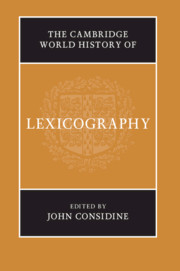Book contents
- The Cambridge World History of Lexicography
- The Cambridge World History of Lexicography
- Copyright page
- Contents
- Contributors
- Editor’s Acknowledgements
- Introduction
- Part I The Ancient World
- Part II The Pre-Modern World
- Part III The Modern World: Continuing Traditions
- Part IV The Modern World: Missionary and Subsequent Traditions
- 26 Missionary Traditions in South America
- 27 Missionary Traditions in Mesoamerica
- 28 Missionary and Subsequent Traditions in North America
- 29 Missionary Traditions in East Asia
- 30 European Traditions in India and Indonesia
- 31 Missionary and Subsequent Traditions in Africa
- 32 Missionary and Other Traditions in Australia
- Appendix 1 The Language Varieties
- Appendix 2 The Lexicographers
- Primary Sources
- Secondary Sources
- Index
29 - Missionary Traditions in East Asia
from Part IV - The Modern World: Missionary and Subsequent Traditions
Published online by Cambridge University Press: 01 September 2019
- The Cambridge World History of Lexicography
- The Cambridge World History of Lexicography
- Copyright page
- Contents
- Contributors
- Editor’s Acknowledgements
- Introduction
- Part I The Ancient World
- Part II The Pre-Modern World
- Part III The Modern World: Continuing Traditions
- Part IV The Modern World: Missionary and Subsequent Traditions
- 26 Missionary Traditions in South America
- 27 Missionary Traditions in Mesoamerica
- 28 Missionary and Subsequent Traditions in North America
- 29 Missionary Traditions in East Asia
- 30 European Traditions in India and Indonesia
- 31 Missionary and Subsequent Traditions in Africa
- 32 Missionary and Other Traditions in Australia
- Appendix 1 The Language Varieties
- Appendix 2 The Lexicographers
- Primary Sources
- Secondary Sources
- Index
Summary
East Asia, which for our purposes includes the Philippines, Vietnam, Japan, and China, is not an area defined by a uniform culture. Before Christian missionaries arrived there in the sixteenth century, it was the home to the long and complex Chinese lexicographical tradition, and to those of what may be called the Chinese periphery; these are discussed from their beginnings to 1700 or 1800 in Chapters 3, 6, and 10. These older traditions continued, variously modified, after contact with the new traditions of missionary lexicography: for that of Chinese, see Chapter 15, and for those of Japanese, Korean, and Vietnamese, see Chapter 16.
A result was that missionary lexicographers in East Asia, unlike their counterparts in the Americas, Africa, and Australasia, could benefit from existing educational systems and methods, particularly of teaching Japanese and Chinese. So, many dictionaries produced by missionaries in East Asia share a distinctive set of features. Of course, some basic features of European origin were shared by all missionary dictionaries, but generally the works in Asia form a highly diverse, but coherent, group.
- Type
- Chapter
- Information
- The Cambridge World History of Lexicography , pp. 614 - 633Publisher: Cambridge University PressPrint publication year: 2019



